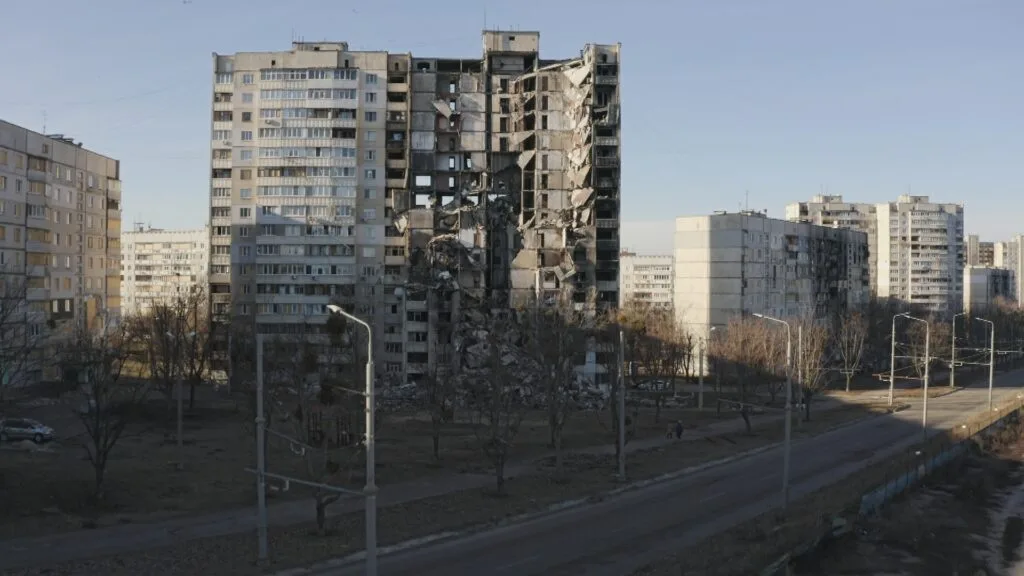
Dispatch
A Year of War in Kharkiv, Ukraine
February 23, 2023
Share
During the early months of Russia’s assault on Ukraine, filmmakers Mani Benchelah and Patrick Tombola documented the lives of civilians and first responders trying to survive in Kharkiv, a Ukrainian city near the border of Russia. Their work became the FRONTLINE film Ukraine: Life Under Russia’s Attack, released in August of 2022.
An updated version of the documentary, released in February 2023, revisits many of the Ukrainians Benchelah and Tombola first profiled and takes us to the present day — a year after Russia’s invasion began.
Joining FRONTLINE editor-in-chief and executive producer Raney Aronson-Rath after their most recent reporting trip to Kharkiv, Benchelah and Tombola reflect on documenting how the region and its inhabitants have been changed by a year of war.
“The new Ukraine is one where everyone is extremely conscious of how close they had come to death,” Tombola said. “Their mindset has dramatically changed, and there’s a real sense of having all shared a very defining moment in their life.”
The updated Ukraine: Life Under Russia’s Attack documentary is now streaming on FRONTLINE’s website, in the PBS App and on FRONTLINE’s YouTube channel.
NEWS ARCHIVE: We are witnessing history.
RANEY ARONSON-RATH: February 24th marks one year since Russia began its assault on Ukraine.
NEWS ARCHIVE: Russia has invaded Ukraine, starting a war.
NEWS ARCHIVE: From the north, the east, and the south, Russia has attacked Ukraine with airstrikes, missiles, and troops.
RANEY ARONSON-RATH: One of their first targets was Ukraine’s second largest city Kharkiv, located near the Russian border. During the first few months of the war, when the city was under near constant attack, filmmakers Mani Benchelah and Patrick Tombola were on the ground in Kharkiv.
RANEY ARONSON-RATH: They followed first responders and displaced families trying to survive under truly harrowing conditions.
ROMAN: It was scary for everybody. It’s not like, “OK, I’m ready to die and I’m not afraid.” All of us afraid.
RANEY ARONSON-RATH:Their work became the FRONTLINE documentary Ukraine: Life Under Russia’s Attack. They joined me today after returning from another trip to Kharkiv, and we released an updated version of the film based on Mani and Patrick’s new reporting. I’m Raney Aronson-Rath, editor-in-chief and executive producer of FRONTLINE, and this is the FRONTLINE Dispatch.
RANEY ARONSON-RATH: Mani and Patrick, thanks so much for being here on the Dispatch.
MANI BENCHELAH: Thank you, Raney. Thank you for having us.
PATRICK TOMBOLA: Thank you very much.
RANEY ARONSON-RATH: So as we’re talking there are real fears that Russia is going to launch a major offensive really soon. We saw some of that starting this week. Um, I know you’ve just gotten back from Kharkiv, so tell me what it’s like there. What’s the mood like there?
MANI BENCHELAH: Well in Kharkiv when we were there, um, like in January, um, I mean for sure the mood was completely different than like one year ago when we filmed, um, the bulk of the film. Um, you know, like a lot of people had come back because, um, the Russian Army was much further away than it used to be. So there was less, uh, shelling. Um, so there was a lot of you know, people who came back in there, a lot of, um, restaurants and cafes and, I mean, life had come back, uh, in a semi-normal way, obviously because the country’s at war and because of the country, even like Kharkiv itself, were still getting the brunt of like, you know, uh, occasional, uh, missile attack on energy infrastructure mainly, and military targets and so on, but it wasn’t as, as severe as it was, uh, eight months before.
PATRICK TOMBOLA: What, what I noticed, just picking up from you in terms of the feeling Kharkiv was that sort of the the adrenaline of the first, uh, two or three months where people were just fighting to survive, you know, and every day was just, uh, you know, not taken for granted was that in a way they got used to that sort of long term war of attrition mood and, and I felt like some people were less, um, uh, less like, oh, you know, we’re just gonna resist no matter what, but just realized that it was there for the long haul. And, and there were also some more mental health issues of just like the, the impact of nine months of war on some of the, of the characters. Before I felt there was more defiance, and now there was also a sense of like, well, you know, it’s, it’s not gonna be easy.
RANEY ARONSON-RATH: Right.
MANI BENCHELAH: And, sorry, if I can just add one thing. Regardless of the level of danger and the military operation and all this, the consequences of all those attacks and ha has been obviously enormous. And we could see it on the people that we had followed. You know, some of them had lost their home. They had no nowhere to, to live anymore. Like the impact on their, um, daily life has been tremendous even if there are less attacks than there used to be.
RANEY ARONSON-RATH: Right, right. So Mani, let’s start with you. Take me back to a year ago. When did you know that you wanted to go to Kharkiv?
MANI BENCHELAH: Uh, well, I, I was obviously, um, very much focused on what was going on in, in Ukraine, seeing the tension rising and rising and, you know, understanding that something really bad might happen. So I was already following what was going on and discussing with Patrick actually, uh, about collaborating together in Ukraine and I didn’t even have the time to take my flight ticket yet that the Russian army invaded. And so within two days I said, okay, I have to go right now. And I, I took my flights and, um, and, and found out how I could enter the country and, and where should I go. So yeah, it’s like, it was, it was total chaos at the border — had so many, I mean, it was really such a level of despair. You see all those refugees fleeing as, as quick as they could. Uh, those, those lines, those vehicles like for, you know, kilometers and kilometers and kilometers. It was just, uh, impossible for people to get out, uh, in, in a fast way. We found our way in and, um, as you know, uh, arrived in Lviv and then figure out you know that I should go to the capitol to Kyiv, where the Russian army was threatening to seize the capital. And we were trying to find out with, uh, Patrick how to meet and how to start working together. We finally did in Kyiv after a couple of weeks and then we realized that we should go to Kharkiv. Kharkiv was obviously so important because of its size, because of its, uh, geography, because of the implication as regards to the Russian speaking population, all of this. And at the same time we realized also that it was really undercovered. The bulk of, uh, the journalists were working in Kyiv — were rightly so. Uh, there needed to be a lot of, uh, attention, but we understood that Kharkiv was not getting enough media attention, and we should tell the story of that, uh, city.
RANEY ARONSON-RATH: Yeah. And then Patrick, how do you intersect? Like, just tell me the first moment where you realized, okay, we’re going to Kharkiv and, and tell me why Kharkiv.
PATRICK TOMBOLA: Sure. Um, I just wanted to, uh, start from, from the beginning. I was in, uh, Ukraine before the war. I had gone with, uh, another colleague of mine to cover the, uh, environmental damage in Donbas. And I was actually in Mariupol, uh, the night of the attack. So I was woken up at 4:30 by just some huge explosions. And, uh, the Russian lines were only eight miles from the center of Mariupol where we were staying. And so that was the very beginning. And, uh, I ended up in Kharkiv actually, uh, 10, 10 days before meeting, Mani, uh, because the main government building had just been, uh, destroyed by a massive missile. And we wanted to do the eastern front, but uh, we quickly realized that Kharkiv because of its sort of like multicultural background and it’s, uh, you know, close, uh, historical and uh, and economic ties, uh, to Russia was a good place to start and, uh, we arrived in Kharkiv a city that was definitely empty. We would be driving around and there’d be like maybe four or five cars, uh, that we would meet every half a day. Uh, we stayed in a one of the few places, the hotels that was open, and we very quickly just met our characters that organically developed into just a beautiful web of, uh, of interconnected characters that represented all different aspects of the city and of the struggle against the invasion and of the will to survive the invasion, I must add.
RANEY ARONSON-RATH: Mm, exactly. I mean, I, it’s really, really amazing to think back to that time and then the fact that you, you both have been covering this since. Okay. So one of the most brilliant things about the film, you know, is it’s clearly driven by the characters that you’ve found. Why don’t you just take a moment and tell me about Roman. He’s just such a wonderful character. Let’s talk about him first.
MANI BENCHELAH: Yeah, well, Roman is, is a firefighter— deputy chief of the fire station in one of the neighborhoods of Kharkiv. And because of the danger, he had decided to move his family to the fire station. They couldn’t stay at their house and his wife refused to leave the city. She wanted to be close to her husband and they, they, they have a, a, a young daughter, Violetta. And so all the family moved to the fire station. We met him very early on. We had just arrived in Kharkiv and he was, uh, with his team trying to excavate, uh, people out of the rubbles, trying to find out survivors. So we, we very early — it was like within days that we were in Kharkiv, probably the second day, I don’t remember. But, uh, we went to a building that had just been bombed. And, um, we wanted to, to approach the firefighters who were dealing with that, with this kind of situation on a daily basis. And we arrive to the site. The building had been bombed the previous day, and they had been, uh, trying to, um, take out all the rubbles to, uh, recover the corpse of a woman who had been killed, uh, during the, the shelling and, and they had been working on it all night. Roman saw us and he was like, who, who are you guys? What are you doing? And instantly he said, follow me. And we went all the way up and he started like explaining the whole situation in front of us.
His English also was, you know, amazing. And that’s it. And then that’s how we started.
RANEY ARONSON-RATH: I just really love that story. Um, and I think I wanna jump to the present day with Roman. Just tell me about Roman now.
PATRICK TOMBOLA: Well, I mean, we’ve met Roman lately in, uh, in Germany, and it was, uh, I mean, we found some of the same traits as before, just the very uh, positive and happy person. I mean, he’s always just this like huge, you know, 130 kilo by a meter-ninety-five, you know, he’s like, uh, a, a mountain that hugs you, you know? It’s just a very welcoming, very warm person. You know, if you want, you know, if you, if you’re scared, uh, you know, in a building on fire, you definitely want someone like him to come and rescue you. There’s no doubt about it. Um, so I mean, we, we, we found some of that and, and he was obviously very happy that, um, that his wife, Marina and his, uh, and his daughter of Violetta, uh, were in safe hands, uh, in Germany. I mean, it, it, it felt in a way a little bit strange in the sense that Violetta, uh, started really liking Germany and just did not actually want to go back to, I mean, she said she didn’t really want to go back to Ukraine. Um, so, you know, we realized how the older generation was always thinking about Kharkiv and, and really missing, you know, the air. And instead as sort of, you know, a young girl was just like, you know, I can, I can easily just be in Germany now. I don’t, I don’t really. I mean, uh, you know, perhaps a little bit of the trauma coming out as well. But, you know, he keeps on saying that she’s not traumatized. But, you know, I think she is a little bit, cuz I mean, seeing all the damage and everything. Um, but really, I mean, uh, Roman is, uh, 100%, sure that Ukraine is going to win, but he isn’t sure either that his future lies, you know, solely in Ukraine. He loves his country. He wants to stay there until the war is won. But he says perhaps my future is also, you know, uh, giving my daughter some, you know, different opportunities and stuff like that. So, you know, I think the war has changed the, you know, the, the, the trajectory of the family.
RANEY ARONSON-RATH: Yeah, you know, we all fell in love, especially with Roman’s daughter and, um, you know, we’re so happy, you know, so happy to see that she was safe in Germany and that trajectory is really critical to, to the update of the film. Um, so one thing I, I wanted to ask is, let’s just talk about a couple of your other characters, how you found them, and. Why did you choose them?
MANI BENCHELAH: I think we got drawn first by, by places we, we, we knew that, you know, there were some places we needed to be, like the Metro for example. You know, there was so many people, you know, were taking shelter in this Soviet-time metro, hugely protected by obviously, uh, all the cement above. So we, we felt like we needed to focus on some places, so we focused on the metro that was full of refugees. We focused after in Saltivka, in that neighborhood that was under heavy shelling daily. We knew that there were people who hadn’t escaped, who had got trapped in some ways, in some places that were under, uh, schools that where they could hide. Uh, we knew that they were there, people who were really desperate and couldn’t leave because it was so dangerous to, to, to be outside in Saltivka. So they were stranded in that area. So, when we found that place, uh, that we see in the film, um, under the school, we also felt like we needed to stay there. And there’s so many, so, such an amount of people under the school — was like 120, I think, uh, mostly elderly people. So we had to take time to, you know, like get to know the people and make sure that people start to understand who we are, why are we there. And so we were coming back again and again, again and again. Staying, uh, staying for the night to find out who, who we should, uh, focus on after that.
RANEY ARONSON-RATH: So, going forward, if you, if you’re thinking about a year later when you, when you’re thinking about what’s happened to your characters, but also to the city of Kharkiv in Ukraine, can you both talk a little bit about like, how, how people are doing there? I mean, I know we talked about this a bit at the top, but I wanna come back to that idea of how are they doing? Where do we see the future going for Kharkiv and, and what is your plan also on covering it?
PATRICK TOMBOLA: Yeah, Kharkiv for almost 11 months after the invasion is a very different place from, uh, the one we ventured in, uh, uh, in, uh, mid-March, just after the beginning of the invasion. When we were there first, it was basically a ghost town. Um, Russians were some three kilometers outside of the Ring Road of Kharkiv. Uh, they were pounding the northern, uh, uh, Saltivka suburbs very heavily. Now there were Georgian restaurants open. There was, uh, like, you know, food deliveries. There were, there were taxis and, you know, like, uh, a normal city. A lot of the roadblocks within the city had been removed. So there was a sense of, uh, you know, normalcy. But, you know, let’s not be fooled by what normalcy really means in, in the new Ukraine. The new Ukraine is one where, everyone is extremely conscious of how close, uh, they had come to death and how determined Putin is to, uh, change, uh, you know, change and basically obliterate their country. So I think they’ve, uh, they’ve learned a big lesson and they are always on high alert and on standby, and everyone can literally just like drop their, you know, their, their job and, and their civilian clothes for military clothes. Their mindset has dramatically changed and, and there’s a real sense of having all shared, a very defining moment in their life. And this is what I feel brings all Kharkivian together. Like they survived. They fought back and they did not let an aggressor get into their homes. And, and, and there’s a real sense of, of shared, uh, it’s not just about patriotism, it’s not just about even Ukraine. It’s just a shared, you know, sense of having got through it and have prevailed. And that’s, that’s a big deal.
RANEY ARONSON-RATH: Hm. And then, and what does the city feel like when you’re there, yourselves observing it? Just talk through the feeling beyond the characters.
MANI BENCHELAH: Yeah, I mean, currently when last time we, we were there, I think what our, what shocked us most is, is how things had evolved in, in, you know, how, how life was somehow a bit more normal than because it was so dramatic when we were there initially. So there was, yeah, as, as Patrick was mentioning, this sense of like, people knew that they had survived a major attack. Um, but, but there is always this apprehension that this might come back, this might happen again. There is still a lot of, obviously a lot of scars of the onslaught, the initial onslaught. So I mean, lots of the neighborhoods have been, um, heavily, um, shelled, so there’s a lot of destruction. But at the same time the city is already working on rebuilding. I mean, what we were impressed by how, you know, we could see cranes, you know, in all Saltivka we saw so many cranes and so many workers rebuilding all those, um, um, those apartments that, uh, had been hit by the Russian artillery. Um, so yeah. At the same time, as regards to our characters, I think one of the things that really is shocking, is how, how many, how many among them have now their family split. You know, so many, so many of them had to leave. Um, and, um, so part of the family is now in Finland for Vika’s family, the little girl from the Metro and obviously Roman, uh, his family now is in Germany, and that’s the new normal, apparently for Ukrainians is to be split and have family members in Western Europe or Europe as a whole
RANEY ARONSON-RATH: So I’d love to ask you, you know, as journalists documenting this over the last year, what do you hope that people take away from your film?
MANI BENCHELAH: I think, um, one of the most things people take is, uh, the personal connection to people who are in very dire situation. Um, this, this connection to be able to, to connect, uh, to human stories because obviously the war in Ukraine is, is obviously, um, getting, rightly so, a lot of, um, coverage.Sometimes I think maybe, and that’s the feedback that I, I received that, you know, seeing, uh, news, news coverage, um, even though it, it, it is extensive. It, it, it is different than if you are able to follow people, um, individuals, uh, in their lives. Uh, over and over for a long period of time. And then you’ll help other people who are in, you know, thousand kilometers away or on the other side of the globe to connect, uh, at a human level with, with these people facing these events. Yeah.
RANEY ARONSON-RATH: And Patrick, what’s your hope? What’s your biggest hope that people take away from this film?
PATRICK TOMBOLA: Well for me, um, you know, our documentary really needs to be, you know, documentation of, of history. I mean, history is often numbers, is dates, but often people do not associate numbers and dates with uh, people. And I think our job is to make, uh, you know, some very cold, uh, numbers, uh, something very human– to humanize a tragedy. And I think that it’s important that people, when they think of the, of the, you know, aggression and invasion of Ukraine, they can, they can think at our characters as some of the people that have in first person lived, uh, through, uh, through these events and also too, for people to not take for granted the peace and, uh, and, and situation that they, they have lived. I mean, peace is a very frail thing that needs to be looked after and needs to be safeguarded and everyone needs uh, try and be as compassionate as possible in order to make sure that they, you know, don’t stumble into conflict, uh, the way this conflict has started.
RANEY ARONSON-RATH: Thanks so much Mani and Patrick for joining me on the dispatch. And, and thanks for your continuing work in Ukraine.
MANI BENCHELAH: Thank you, Raney.
PATRICK TOMBOLA: Thank you very much.
RANEY ARONSON-RATH: You can see the updated version of Ukraine Life under Russia’s attack on frontline.org, on frontline’s YouTube channel, and on the PBS video app.
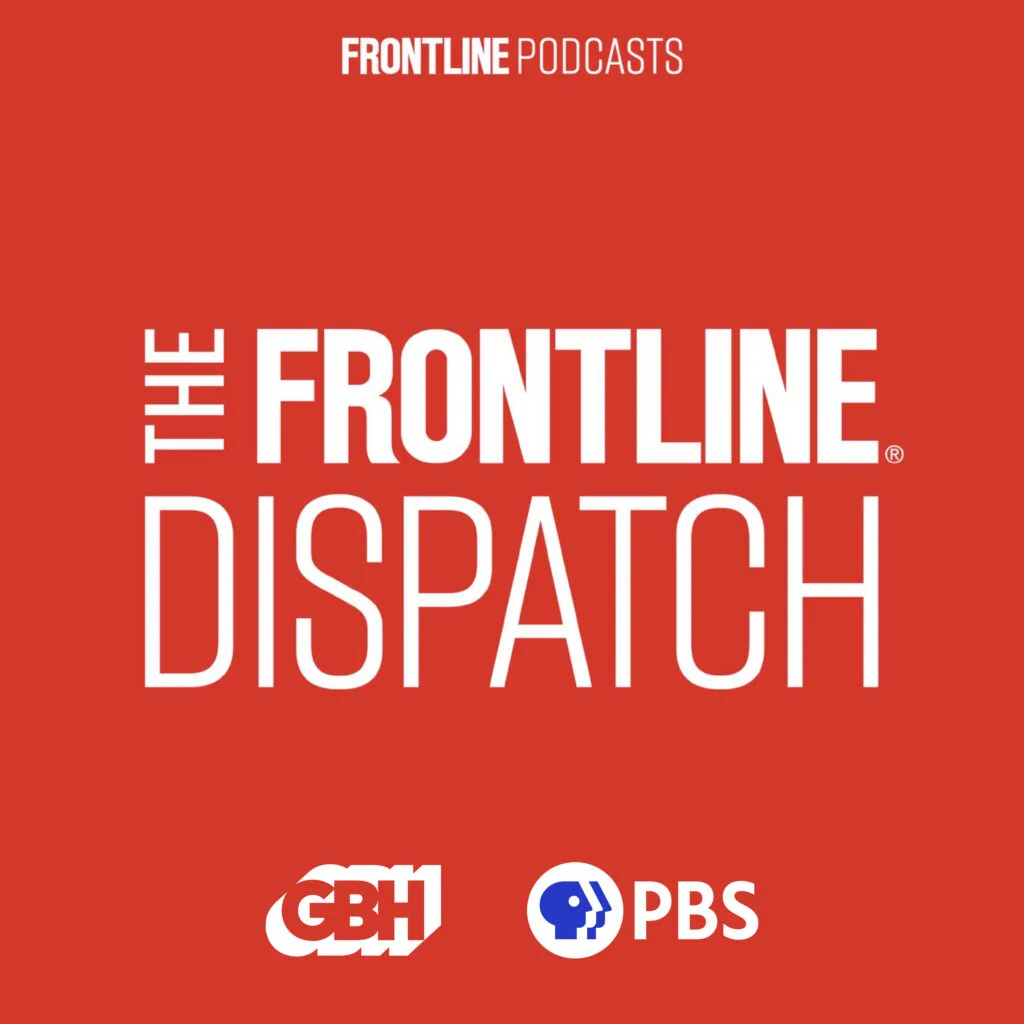
Sign up for FRONTLINE Dispatch Newsletter
Coming Soon
A Subprime Education
FRONTLINE examines allegations of fraud and predatory behavior in the for-profit college industry.
Related Stories
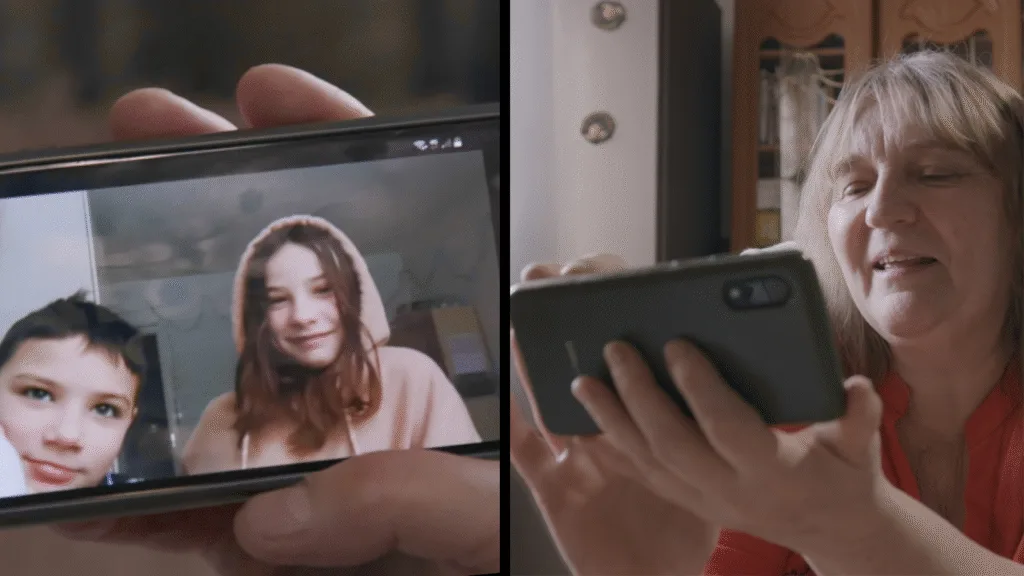
‘Thank God They’re Still Alive’: An Update on a Family Featured in ‘Ukraine: Life Under Russia’s Attack’
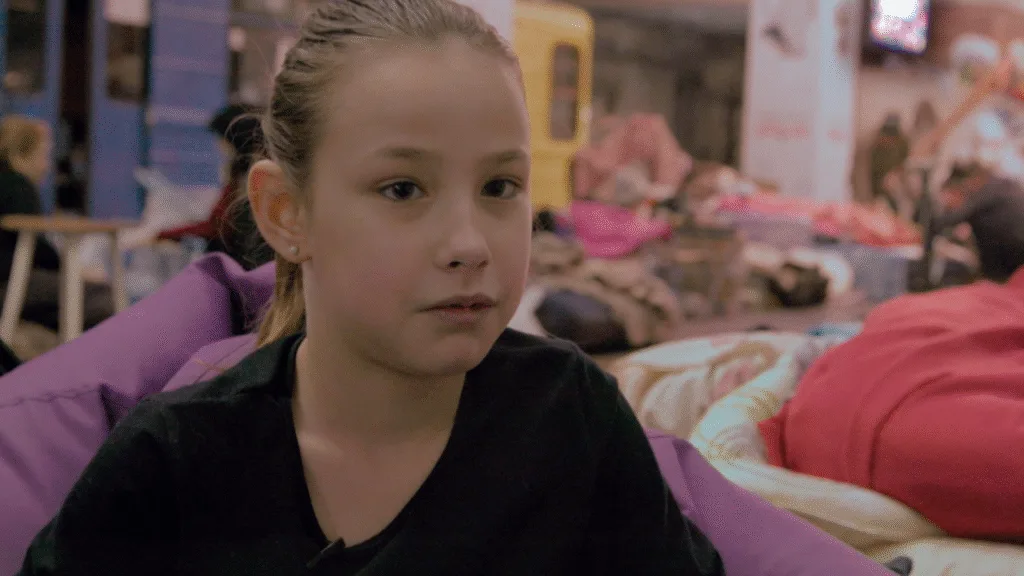
Life Underground: Inside a Kharkiv Metro Station, Home to Hundreds Amid Russia’s Attack on Ukraine
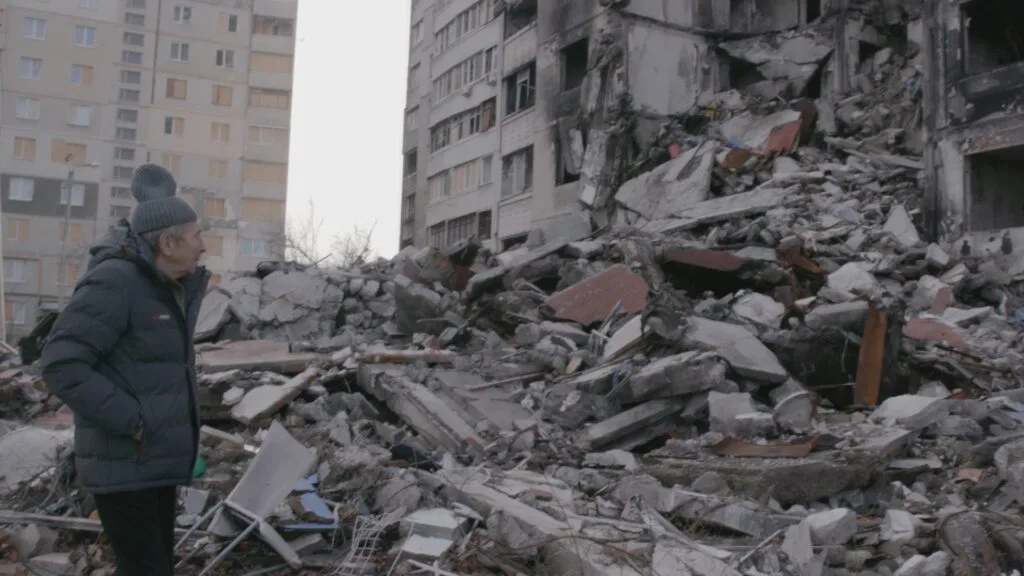
Ukraine: Life Under Russia’s Attack
Related Stories

‘Thank God They’re Still Alive’: An Update on a Family Featured in ‘Ukraine: Life Under Russia’s Attack’

Life Underground: Inside a Kharkiv Metro Station, Home to Hundreds Amid Russia’s Attack on Ukraine

Ukraine: Life Under Russia’s Attack
Policies
Teacher Center
Funding for FRONTLINE is provided through the support of PBS viewers and by the Corporation for Public Broadcasting. Additional funding is provided by the Abrams Foundation; Park Foundation; the John D. and Catherine T. MacArthur Foundation; and the FRONTLINE Journalism Fund with major support from Jon and Jo Ann Hagler on behalf of the Jon L. Hagler Foundation, and additional support from Koo and Patricia Yuen. FRONTLINE is a registered trademark of WGBH Educational Foundation. Web Site Copyright ©1995-2025 WGBH Educational Foundation. PBS is a 501(c)(3) not-for-profit organization.






